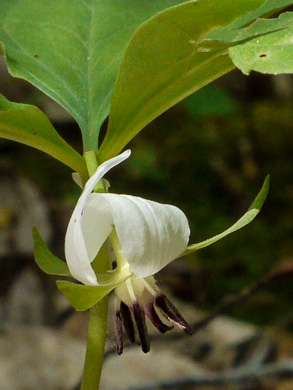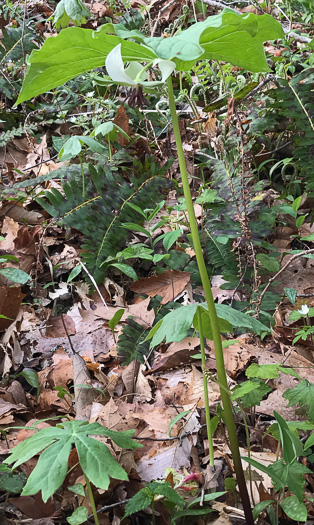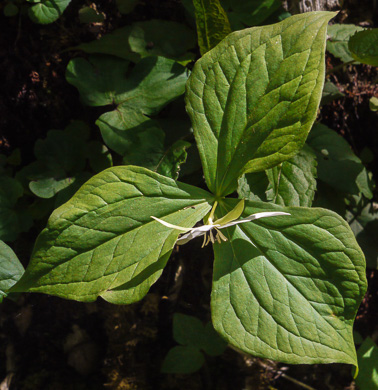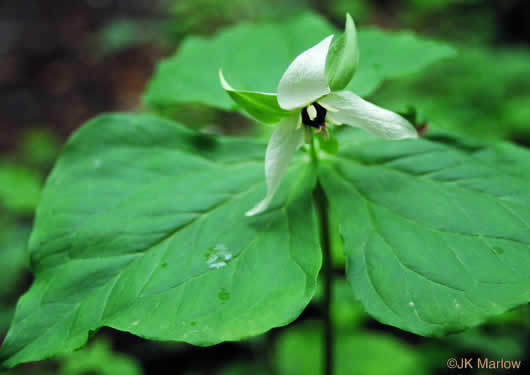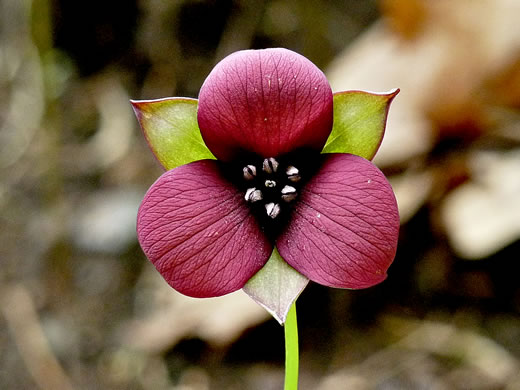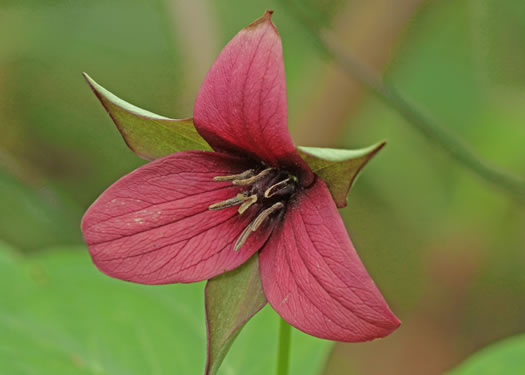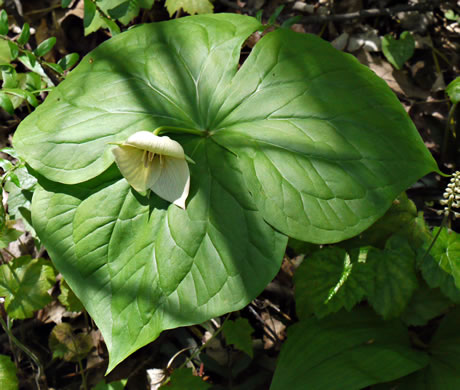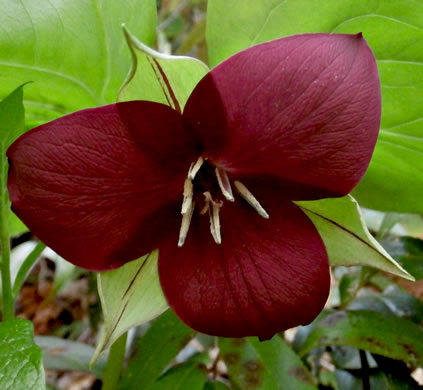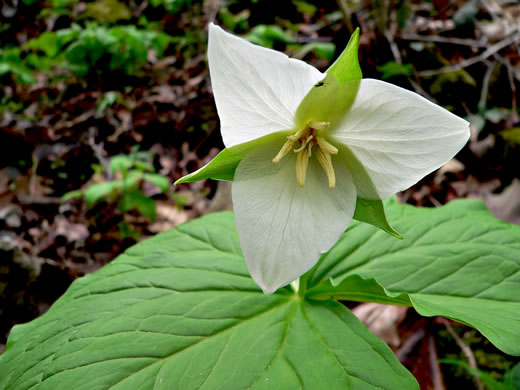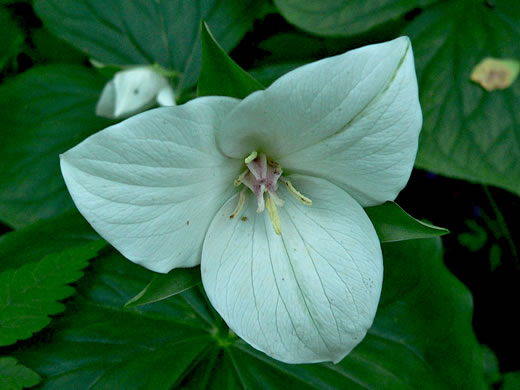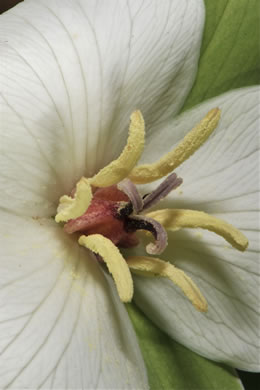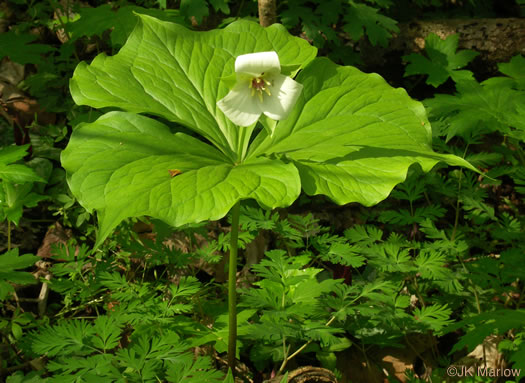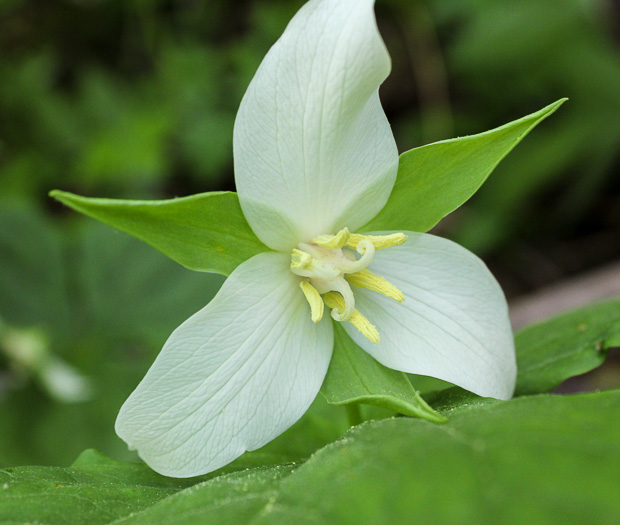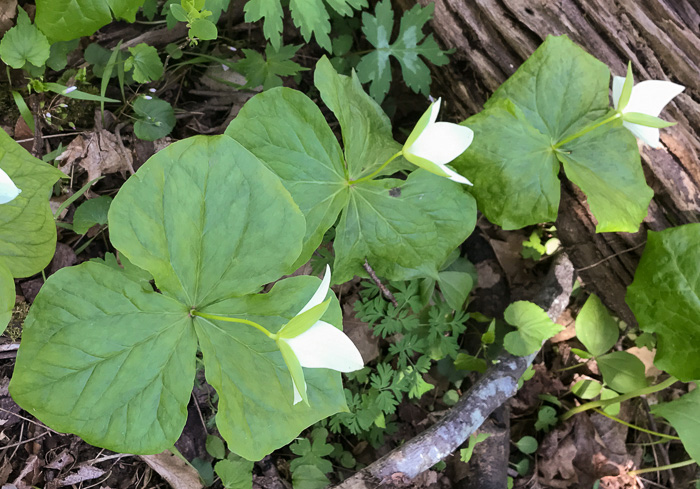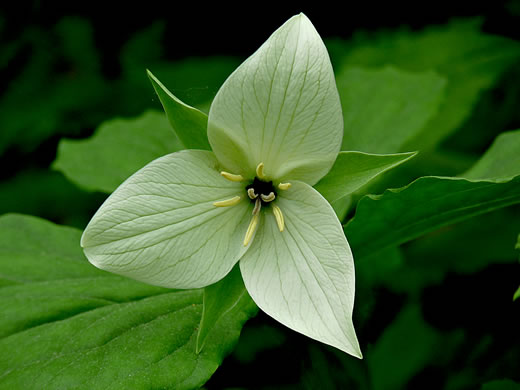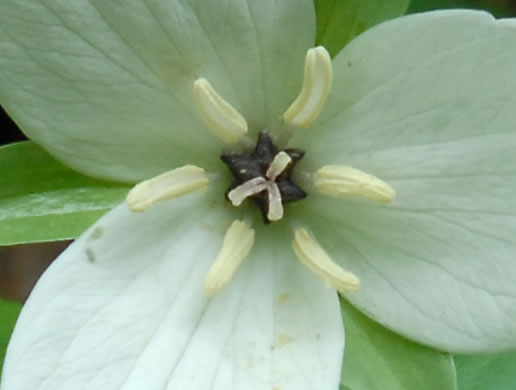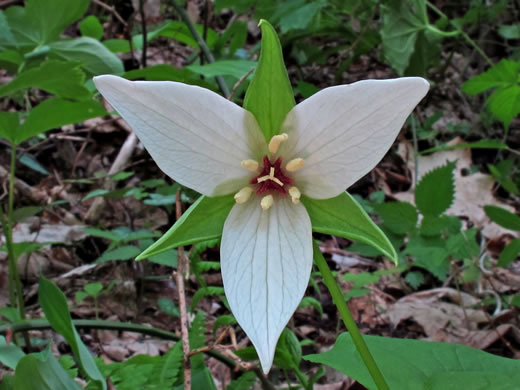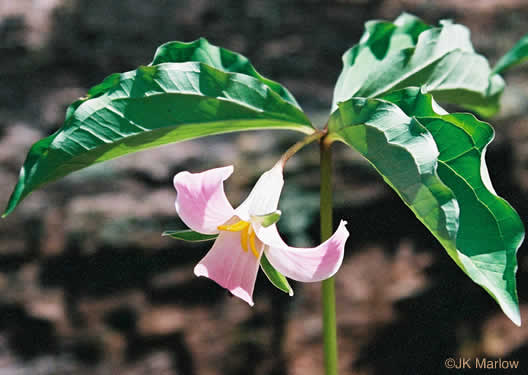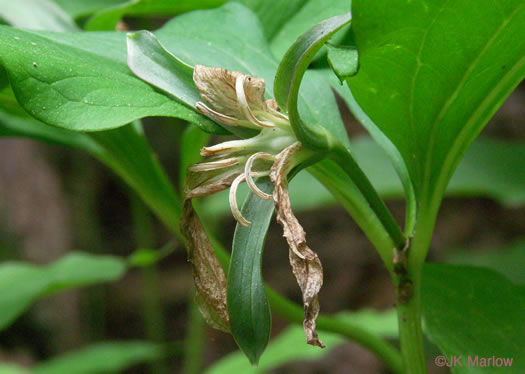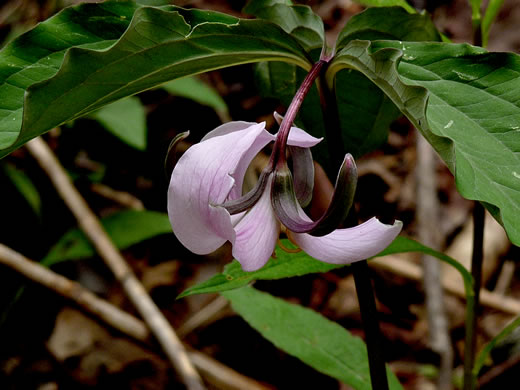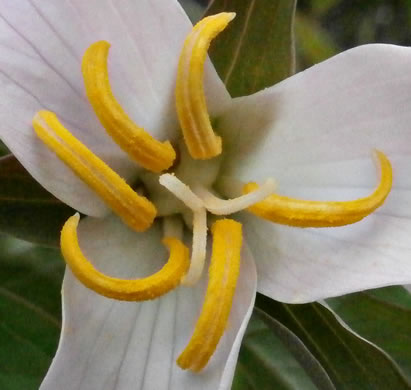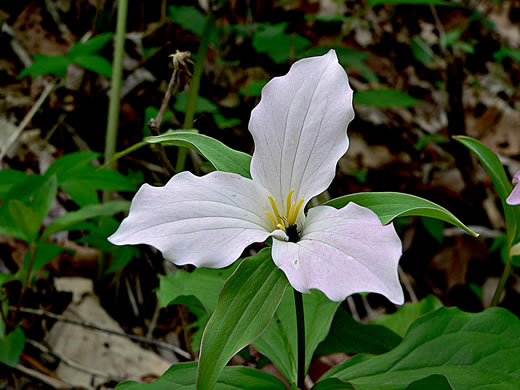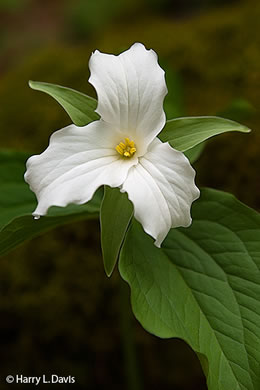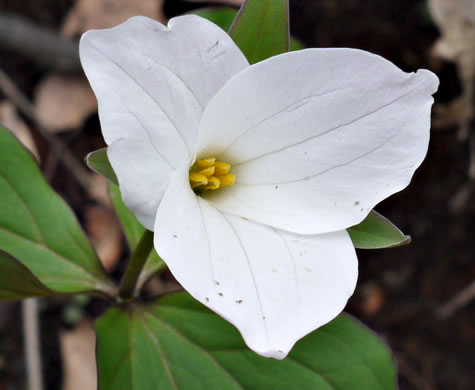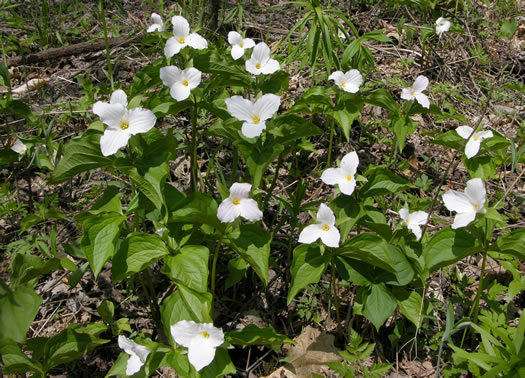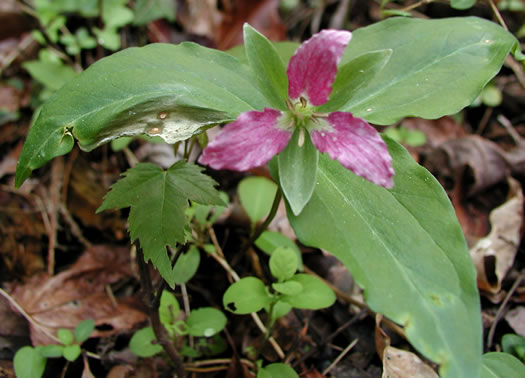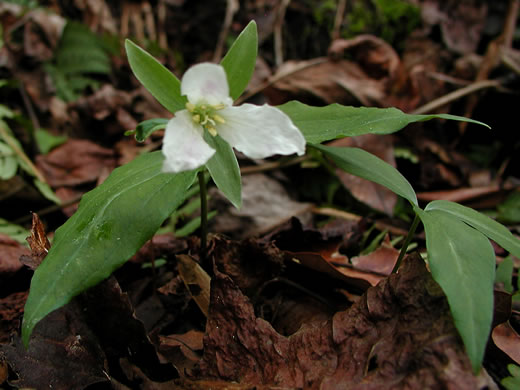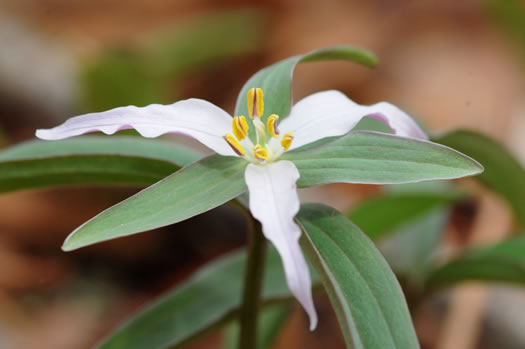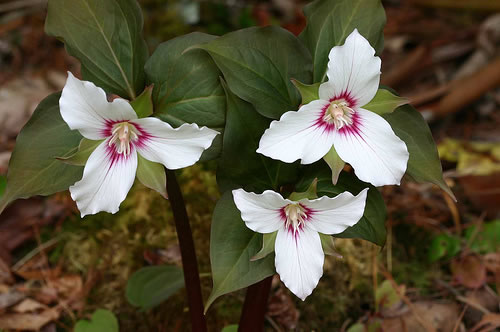Your search found 35 image(s) of flowers of white-flowering Trilliums.
To see larger pictures, click or hover over the thumbnails.
To go to the plant's detail page, click its name.
 Habitat: Rich woodlands and forests over mafic or calcareous rocks
Habitat: Rich woodlands and forests over mafic or calcareous rocks
Petals strongly recurved; ovary mostly white to pink, stamens bicolored, per Trilliums of Georgia (Patrick, 2007).
Pedicel normally below the leaves, when above, the flower facing downward, per Trilliums of Georgia (Patrick, 2007).
Filaments white; anthers lavender to vivid purple and longer than filaments, per Weakley's Flora.
 Habitat: Wooded slopes, usually at middle to high elevations
Habitat: Wooded slopes, usually at middle to high elevations
Stamens & ovary (cup) totally exposed. Sepals & petals (saucer) spreading, per Trilliums of Georgia (Patrick, 2007).
All Trillium erectum have a dark ovary, per Wildflowers of the Southern Mountains (Smith, 1998).
 Habitat: Coves and moist slopes
Habitat: Coves and moist slopes
Flowers small and generally maroon, but petals may be white, per Weakley's Flora (2015).
The flower gaping in profile; petals ovate, gradually spreading, per Trilliums of Georgia (Patrick, 2007).
 Habitat: Cove forests, other rich forests
Habitat: Cove forests, other rich forests
The largest flower of all Trillium species, often nearly 4" in diameter, per Great Smoky Mountains Wildflowers (Campbell, Hutson, Sharp, & Hutson, 1962).
Stamens with yellow to maroon anthers, much longer than purple-black ovary, per Wildflowers of Tennessee (Carman, 2005).
Petals strongly overlapping, usually maroon (rarely white or whitish), per Weakley's Flora (2015).
 Habitat: Moist coves over mafic or calcareous rocks
Habitat: Moist coves over mafic or calcareous rocks
Petals are white (rarely maroon), spreading, and broadly lance-shaped, per Wildflowers of Tennessee (Carman, 2005).
Ovulary is white to light pink and strongly 6-angled, per Wildflowers of the Eastern United States (Duncan & Duncan, 1999).
Filaments shorter than the creamy anthers; ovary with prominent stigmas, per Trilliums of Georgia (Patrick, 2007).
White-to-pink, protruding, flask-shaped ovary, per Wildflowers of Tennessee, the Ohio Valley, and the Southern Appalachians (Horn, Cathcart, Hemmerly, & Duhl, 2005).
Flower on a 1.6-5" stalk that may extend above or bend under the leaves, per Wildflowers of Tennessee (Carman, 2005).
Unlike T. grandiflorum, this corolla is not funnel-shaped, per Wildflowers of the Eastern United States (Duncan & Duncan, 1999).
 Habitat: Very rich soils of slopes and coves over mafic or calcareous rocks, often also in or near seepage
Habitat: Very rich soils of slopes and coves over mafic or calcareous rocks, often also in or near seepage
Petals broad enough to overlap at base; stamens much longer than the ovary, per Trilliums of Georgia (Patrick, 2007).
Flowers have a cup-shaped profile [compare T. erectum's cup and saucer], per Trilliums of Georgia (Patrick, 2007).
Stamens much longer than ovary; ovary black to purplish-black, per Trilliums of Georgia (Patrick, 2007).
Ovary dark purple and strongly angled, per Guide to the Wildflowers of SC, 1st ed. (Porcher & Rayner, 2001).
 Habitat: Rich forests
Habitat: Rich forests
Stamens much longer than ovary; stigmas pronounced & recoiled, per Trilliums of Georgia (Patrick, 2007).
 Habitat: Bottomland forests, mesic slopes, cove forests
Habitat: Bottomland forests, mesic slopes, cove forests
Petals strongly reflexed above the tube; anthers curved outward, per Trilliums of Georgia (Patrick, 2007).
Ovary white, sharply to obscurely angled, per Vascular Flora of the Carolinas (Radford, Ahles, & Bell, 1968).
Sepals are falcate (strongly arched) and often purplish, per Trilliums of Georgia (Patrick, 2007).
Anthers somewhat twisted, curved outward, stigmas joined into a short style, per Trilliums of Georgia (Patrick, 2007).
 Habitat: Rich coves and mesic slopes, also less typically on ridges over "rich" rock types
Habitat: Rich coves and mesic slopes, also less typically on ridges over "rich" rock types
Sepals 3-6cm long, 1.8-2.5cm wide, horizontally spreading, per Vascular Flora of the Carolinas (Radford, Ahles, & Bell, 1968).
The widely flaring, ruffled white petals quickly fade to pink, per Wildflowers of the Southern Mountains (Smith, 1998).
Petals overlap at the base to form a strongly funnel-shaped flower, per Guide to the Wildflowers of SC, 1st ed. (Porcher & Rayner, 2001).
Flowers above leaves; anthers straight, pale yellow, concealing young ovary, per Trilliums of Georgia (Patrick, 2007).
Flowers resemble trumpets, flaring outward from a tube-like base, per Wildflowers of Tennessee, the Ohio Valley, and the Southern Appalachians (Horn, Cathcart, Hemmerly, & Duhl, 2005).
 Habitat: Acidic forests with hemlocks and heaths
Habitat: Acidic forests with hemlocks and heaths
Flowers weakly trumpet-shaped to merely gaping, per Trilliums of Georgia (Patrick, 2007).
Sepals weakly divergent, 11-22mm x 5-6mm, per Wildflowers of the Eastern United States (Duncan & Duncan, 1999).

Pollen light yellow, anthers purplish-green between anther sacs, per Weakley's Flora.
 Habitat: Acidic soils of ridges, slopes, and bog margins, mostly at high elevations and often associated with Rhododendron, Tsuga, Pinus, or Picea
Habitat: Acidic soils of ridges, slopes, and bog margins, mostly at high elevations and often associated with Rhododendron, Tsuga, Pinus, or Picea
Petals usually white with an inverted red "V" near the base, often undulate, per Vascular Flora of the Carolinas (Radford, Ahles, & Bell, 1968).

